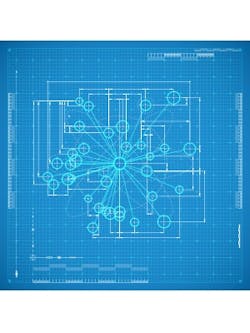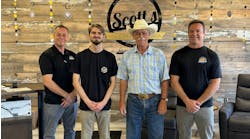Larry Moore has heard it before: Any time productivity levels start to slip, the technician is blamed. But according to Moore, owner of Larry’s AutoWorks in Mountain View, Calif., the technician is only one of five factors affecting efficiency and productivity.
“The layout is a factor, systems and processes is a factor, getting the parts is a factor, having the right job mix is a factor and then the final part is the tech,” he says. “We find that if a tech has the ability to do it and you have everything in place, there’s no reason they can’t be close to 100 percent productivity all the time—if the shop is laid out right.”
Moore has run his five-tech, 15-lift shop with a meticulous eye for productivity and it shows: His staff regularly reports 100 percent productivity and 120 percent efficiency numbers. And he says the anatomy of his technicians’ shop floor has a lot to do with that.
For Dave Markert, owner of Markert Motor Works in Lawrenceville, Ga., a move to a new nine-lift, 7,500-square-foot facility he blueprinted and designed meant a 40 percent increase in efficiency.
Both Markert and Moore agree that the contents of a workbay are crucial for achieving high efficiency numbers, but not every fix is obvious. They highlight seven tips that have helped their repair businesses achieve maximum efficiency levels.
TIP #1: Find the Correct Number of Lifts
You need to figure out what’s right for your shop, but for Moore and Markert, they both agree that maximum efficiency comes from having two lifts per technician, rather than just one or sharing multiple lifts.
“That’s because, often, we get a car in, we have to look it over, we have to write an estimate, we have to call the customer, we have to get approval, we have to get the parts and then we have to put it back together. Every time you have to put a car up on the rack and take it back down, you just lost a fair amount of efficiency,” Moore says. “I used to have a shop where I had one tech per bay. When I went to two lifts per tech, my productivity went up. We produced more work with fewer techs. I’m a firm believer in having bays that are laid out so the guys do not have to pull a car off if they can help it.”
Markert says it also creates a sense of ownership for technicians. They are responsible for keeping those lifts clean and functional, as well as for the logistics of prioritizing work.
“If you go to get started on a project and you only have two lifts to work with—be all, end all, without fail—you know you have to get your stuff in order so you don’t get started on a project and it’s dead, both of your lifts are tied up and you can’t get any more work done,” he says. “That injures you when you’re a flat-rate technician.”
TIP #2: Create a Designated Parts-Delivery Shelf
Markert says it’s far too common in many shops to find techs walking all around the facility—to the front office, the parts room, other areas—looking for parts or checking in on an order. That’s wasting significant time, he says, and it’s costing you in efficiency. Moore says that, ideally, a shop should be set up as a horseshoe with the parts room in the middle, but if your shop isn’t built to handle that, you need to come up with a parts-delivery system to technicians.
“In a perfect world, the technician never has to walk more than 15 steps, “ he says. “Right now, if a technician is working in a very end bay, he would have to walk 700 feet to the office to get a part. Walking back and forth 10 times a day very quickly adds up over a course of time.”
For Markert’s shop, that means a shelving system at each technician’s bay. In the system, a front office worker delivers the parts kit from the office to the tech’s work station, allowing the technician to simply pull the car in and have all the related parts ready to go.
In addition, Markert tries to keep very little inventory in the shop so the tech doesn’t think he can avoid ordering a part and simply find it in the shop.
“It’s a lot easier to already have everything laid out for the techs so they can optimize every minute possible actually fixing a car instead of wandering aimlessly all over the shop being a parts delivery guy,” he says.
“My rule of thumb is that it is easier to do it right than to do it wrong, if I want it done consistently.”
—Larry Moore, owner, Larry’s AutoWorks
TIP #3: Ensure Technicians Have the Correct Equipment in Their Stalls
It’s simple, Moore says: The bays need to be laid out so that everything a technician needs to do their job is within a few steps. At his shop, that means that bays are segmented by make (based on technician expertise) and everything the technician needs for that vehicle make is in the bay.
Each bay at his shop has a trash can, recycling barrel, airline, a small 2.5-foot-by-2.5-foot workbench and a cabinet that has the necessary related tools in it. For instance, the bay that works on German cars will have the German scanners in the cabinet.
“My rule of thumb is that it is easier to do it right than to do it wrong, if I want it done consistently,” he says. “Anything we can do to lay it out and make it more efficient.”
In addition, he makes sure that the alignment and tire bays are kept clear and used for those services only, rather than collecting clutter or tools when not in use.
TIP #4: Keep it Organized
While he tries to have commonly used pieces of equipment and tools in the appropriate bays, Moore says there are some tools that are used sparingly and kept in a larger tool cabinet in the machine area.
However, he emphasizes that those still need to be immaculately organized. The cabinet is assigned by drawer, which are all marked, so technicians can easily find a tool, use it and put it back. For instance, the cabinet has German suspension tool, Asian fuel system and German timing belt drawers.
In addition, for shared pieces of equipment, such as engine hoists or battery chargers, those pieces are assigned to different areas in the shop and have a place marked with tape on the floor. The technicians in that area are responsible for making sure the piece of equipment has been returned to that area at the end of the day.
“It just saves time,” Moore says. “If you know where your tool is, you can just go right there and get it.”
TIP #5: Embrace Technology for Added Efficiency
Each technician at Moore’s shop has a laptop computer with access to ALLDATA, Identifix and iATN. It’s a way for technicians to quickly access service information and resolve any issues during the repair. In addition, they also have access to the shop’s electronic management system, QuickTrac, which allows all technicians to follow their productivity levels. Embracing technology is key, Moore says, and although it can be a big change, doing so can increase efficiency for both the technicians and the shop as a whole.
Beyond management systems, tools from Bolt On Technology (such as the Mobile Manager Pro), or AutoVitals allow shops to use a digital inspection application and repair data look-up. The inspections can be uploaded into the shop’s management system, turned into an estimate and emailed directly to the customer.
TIP #6: De-Clutter Aisles to Keep Vehicles Moving
Before moving into his current building, Moore was in a facility with one door that opened to 10 bays. It wasn’t optimal, he says, and it meant that if a technician didn’t pull a vehicle into a bay all the way, everything else came to a screeching halt.
“It became a problem because somebody would get out of a car and leave it sitting there and then somebody would have to move it and they lost time,” he says.
While he designed his new facility as a drive-through, he has employed a simple trick in both buildings for keeping the aisles clear: Creating a road down the middle of the shop with white lines that cars are not allowed to sit in. It’s a driving area, he says, and it ensures that technicians aren’t wasting time jockeying cars in and out. At his previous facility, where it was an even larger problem, he assigned the shop foreman to make sure the aisle was kept clear at all times.
TIP #7: Don’t get frustrated by building constraints
Not everyone can afford to move into a brand-new building and design it from scratch. But that doesn’t mean that you should just accept your current building’s inefficiencies. Instead, Moore suggests getting creative and considering ways that you can alleviate building constraints.
For example, at his previous shop, one of his bays was so remote that the technician had to walk around a wall and come in through another door. The shop was never able to figure out why that tech’s productivity levels were down until the tech brought up the wall.
“He said, ‘Let me move over to one of the other bays.’ We moved him over and it turned out the other guy was slow then,” he says. “We punched a hole in the wall and put in a door and his productivity came up and stayed up.”



